technical specifications FIAT DUCATO 2012 Owner handbook (in English)
[x] Cancel search | Manufacturer: FIAT, Model Year: 2012, Model line: DUCATO, Model: FIAT DUCATO 2012Pages: 287, PDF Size: 4.5 MB
Page 228 of 287
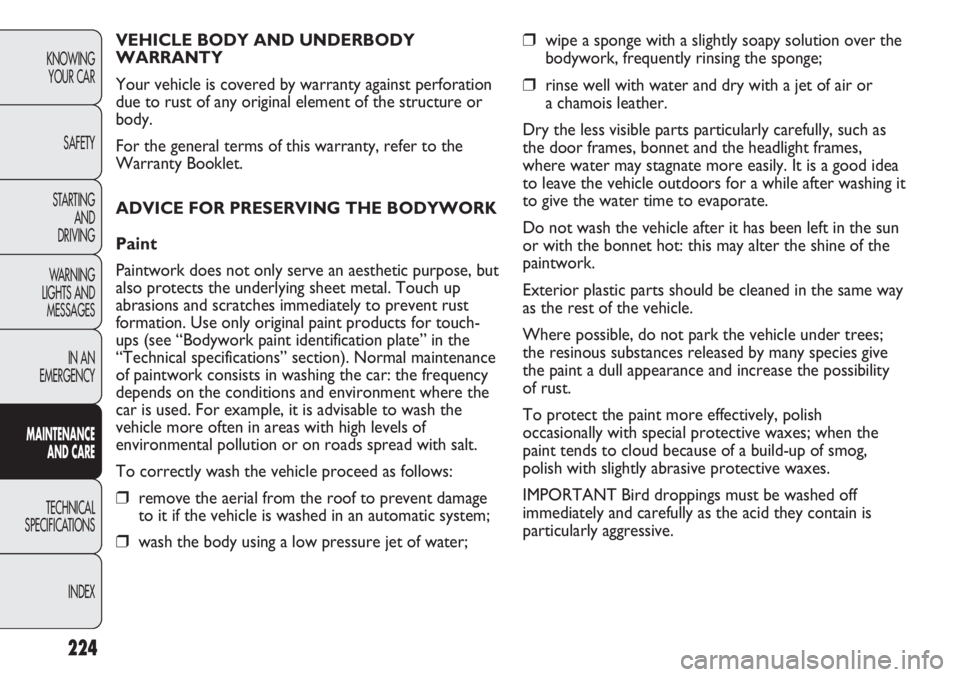
224
KNOWING
YOUR CAR
SAFETY
STARTING
AND
DRIVING
WARNING
LIGHTS AND
MESSAGES
IN AN
EMERGENCY
MAINTENANCE
AND CARE
TECHNICAL
SPECIFICATIONS
INDEX
❒wipe a sponge with a slightly soapy solution over the
bodywork, frequently rinsing the sponge;
❒rinse well with water and dry with a jet of air or
a chamois leather.
Dry the less visible parts particularly carefully, such as
the door frames, bonnet and the headlight frames,
where water may stagnate more easily. It is a good idea
to leave the vehicle outdoors for a while after washing it
to give the water time to evaporate.
Do not wash the vehicle after it has been left in the sun
or with the bonnet hot: this may alter the shine of the
paintwork.
Exterior plastic parts should be cleaned in the same way
as the rest of the vehicle.
Where possible, do not park the vehicle under trees;
the resinous substances released by many species give
the paint a dull appearance and increase the possibility
of rust.
To protect the paint more effectively, polish
occasionally with special protective waxes; when the
paint tends to cloud because of a build-up of smog,
polish with slightly abrasive protective waxes.
IMPORTANT Bird droppings must be washed off
immediately and carefully as the acid they contain is
particularly aggressive. VEHICLE BODY AND UNDERBODY
WARRANTY
Your vehicle is covered by warranty against perforation
due to rust of any original element of the structure or
body.
For the general terms of this warranty, refer to the
Warranty Booklet.
ADVICE FOR PRESERVING THE BODYWORK
Paint
Paintwork does not only serve an aesthetic purpose, but
also protects the underlying sheet metal. Touch up
abrasions and scratches immediately to prevent rust
formation. Use only original paint products for touch-
ups (see “Bodywork paint identification plate” in the
“Technical specifications” section). Normal maintenance
of paintwork consists in washing the car: the frequency
depends on the conditions and environment where the
car is used. For example, it is advisable to wash the
vehicle more often in areas with high levels of
environmental pollution or on roads spread with salt.
To correctly wash the vehicle proceed as follows:
❒remove the aerial from the roof to prevent damage
to it if the vehicle is washed in an automatic system;
❒wash the body using a low pressure jet of water;
Page 229 of 287
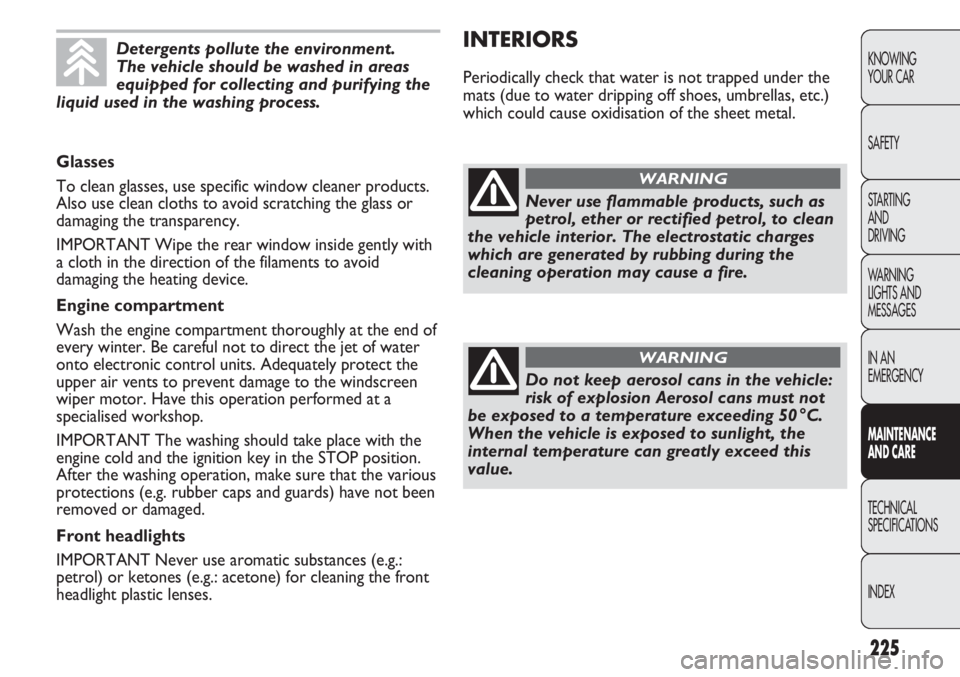
225
KNOWING
YOUR CAR
SAFETY
STARTING
AND
DRIVING
WARNING
LIGHTS AND
MESSAGES
IN AN
EMERGENCY
MAINTENANCE
AND CARE
TECHNICAL
SPECIFICATIONS
INDEX
INTERIORS
Periodically check that water is not trapped under the
mats (due to water dripping off shoes, umbrellas, etc.)
which could cause oxidisation of the sheet metal.
Detergents pollute the environment.
The vehicle should be washed in areas
equipped for collecting and purifying the
liquid used in the washing process.
Glasses
To clean glasses, use specific window cleaner products.
Also use clean cloths to avoid scratching the glass or
damaging the transparency.
IMPORTANT Wipe the rear window inside gently with
a cloth in the direction of the filaments to avoid
damaging the heating device.
Engine compartment
Wash the engine compartment thoroughly at the end of
every winter. Be careful not to direct the jet of water
onto electronic control units. Adequately protect the
upper air vents to prevent damage to the windscreen
wiper motor. Have this operation performed at a
specialised workshop.
IMPORTANT The washing should take place with the
engine cold and the ignition key in the STOP position.
After the washing operation, make sure that the various
protections (e.g. rubber caps and guards) have not been
removed or damaged.
Front headlights
IMPORTANT Never use aromatic substances (e.g.:
petrol) or ketones (e.g.: acetone) for cleaning the front
headlight plastic lenses.
Never use flammable products, such as
petrol, ether or rectified petrol, to clean
the vehicle interior. The electrostatic charges
which are generated by rubbing during the
cleaning operation may cause a fire.
WARNING
Do not keep aerosol cans in the vehicle:
risk of explosion Aerosol cans must not
be exposed to a temperature exceeding 50 °C.
When the vehicle is exposed to sunlight, the
internal temperature can greatly exceed this
value.
WARNING
Page 230 of 287
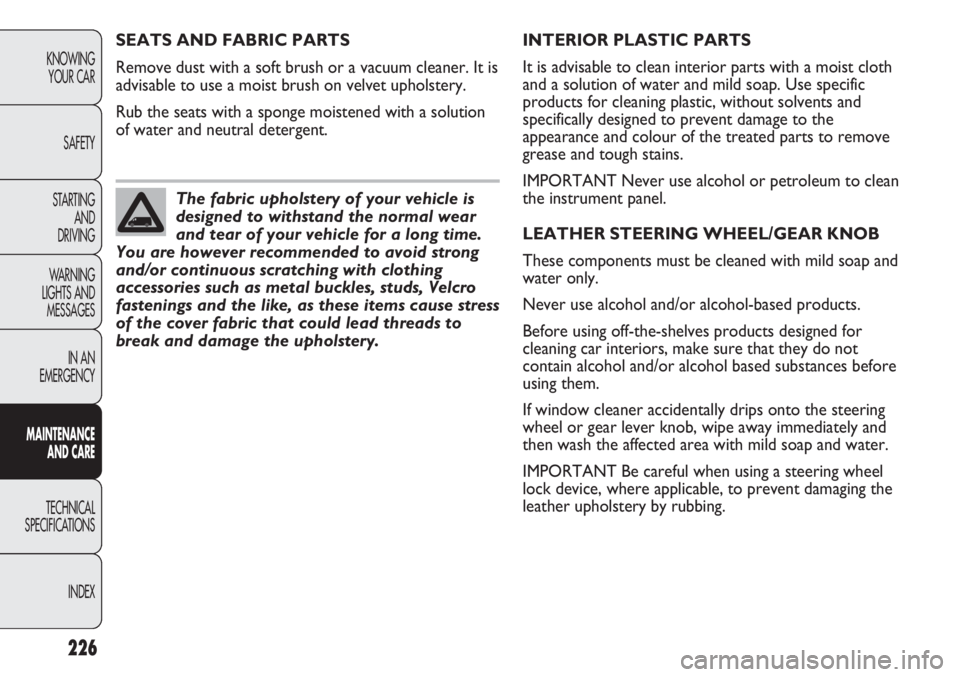
226
KNOWING
YOUR CAR
SAFETY
STARTING
AND
DRIVING
WARNING
LIGHTS AND
MESSAGES
IN AN
EMERGENCY
MAINTENANCE
AND CARE
TECHNICAL
SPECIFICATIONS
INDEX
INTERIOR PLASTIC PARTS
It is advisable to clean interior parts with a moist cloth
and a solution of water and mild soap. Use specific
products for cleaning plastic, without solvents and
specifically designed to prevent damage to the
appearance and colour of the treated parts to remove
grease and tough stains.
IMPORTANT Never use alcohol or petroleum to clean
the instrument panel.
LEATHER STEERING WHEEL/GEAR KNOB
These components must be cleaned with mild soap and
water only.
Never use alcohol and/or alcohol-based products.
Before using off-the-shelves products designed for
cleaning car interiors, make sure that they do not
contain alcohol and/or alcohol based substances before
using them.
If window cleaner accidentally drips onto the steering
wheel or gear lever knob, wipe away immediately and
then wash the affected area with mild soap and water.
IMPORTANT Be careful when using a steering wheel
lock device, where applicable, to prevent damaging the
leather upholstery by rubbing. SEATS AND FABRIC PARTS
Remove dust with a soft brush or a vacuum cleaner. It is
advisable to use a moist brush on velvet upholstery.
Rub the seats with a sponge moistened with a solution
of water and neutral detergent.
The fabric upholstery of your vehicle is
designed to withstand the normal wear
and tear of your vehicle for a long time.
You are however recommended to avoid strong
and/or continuous scratching with clothing
accessories such as metal buckles, studs, Velcro
fastenings and the like, as these items cause stress
of the cover fabric that could lead threads to
break and damage the upholstery.
Page 231 of 287
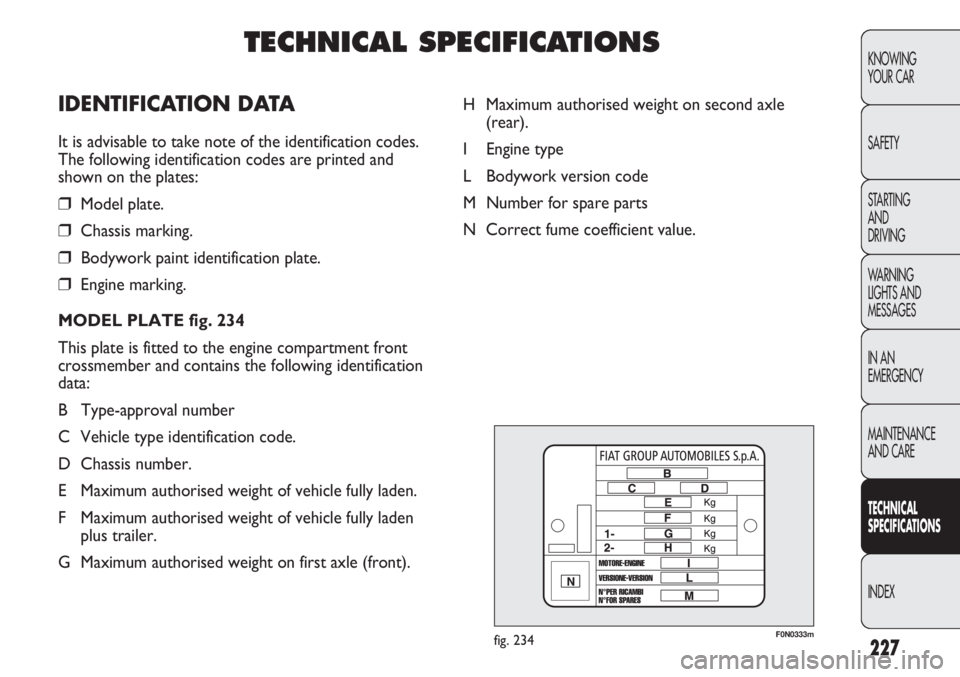
227
KNOWING
YOUR CAR
SAFETY
STARTING
AND
DRIVING
WARNING
LIGHTS AND
MESSAGES
IN AN
EMERGENCY
MAINTENANCE
AND CARE
TECHNICAL
SPECIFICATIONS
INDEX
F0N0333mfig. 234
H Maximum authorised weight on second axle
(rear).
I Engine type
L Bodywork version code
M Number for spare parts
N Correct fume coefficient value.
TECHNICAL SPECIFICATIONS
IDENTIFICATION DATA
It is advisable to take note of the identification codes.
The following identification codes are printed and
shown on the plates:
❒Model plate.
❒Chassis marking.
❒Bodywork paint identification plate.
❒Engine marking.
MODEL PLATE fig. 234
This plate is fitted to the engine compartment front
crossmember and contains the following identification
data:
B Type-approval number
C Vehicle type identification code.
D Chassis number.
E Maximum authorised weight of vehicle fully laden.
F Maximum authorised weight of vehicle fully laden
plus trailer.
G Maximum authorised weight on first axle (front).
Page 232 of 287
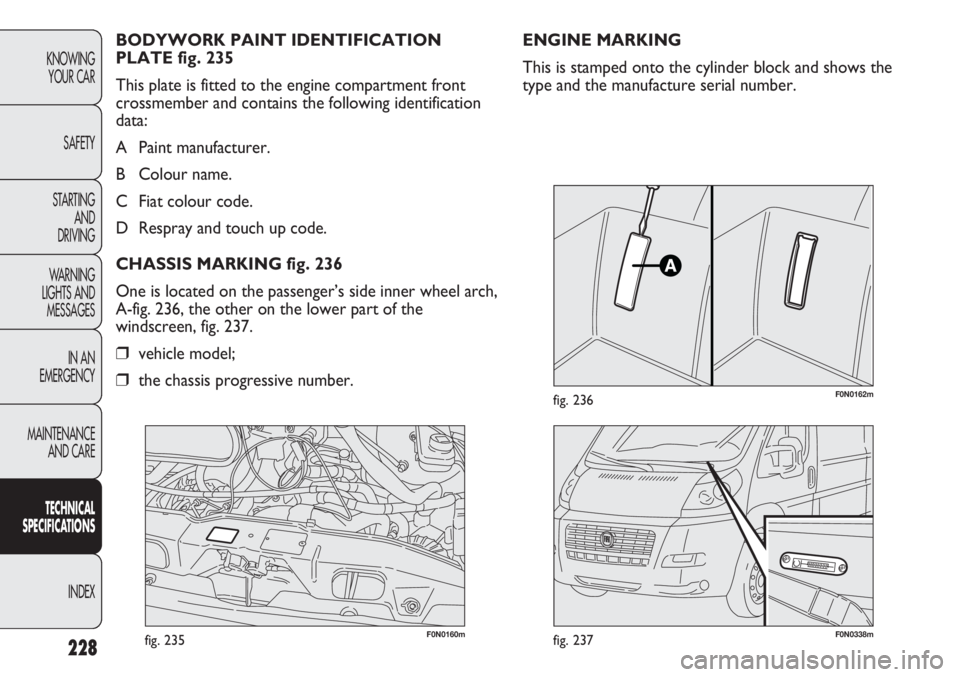
228
KNOWING
YOUR CAR
SAFETY
STARTING
AND
DRIVING
WARNING
LIGHTS AND
MESSAGES
IN AN
EMERGENCY
MAINTENANCE
AND CARE
TECHNICAL
SPECIFICATIONS
INDEX
F0N0160mfig. 235F0N0338mfig. 237
F0N0162mfig. 236
ENGINE MARKING
This is stamped onto the cylinder block and shows the
type and the manufacture serial number. BODYWORK PAINT IDENTIFICATION
PLATE fig. 235
This plate is fitted to the engine compartment front
crossmember and contains the following identification
data:
A Paint manufacturer.
B Colour name.
C Fiat colour code.
D Respray and touch up code.
CHASSIS MARKING fig. 236
One is located on the passenger’s side inner wheel arch,
A-fig. 236, the other on the lower part of the
windscreen, fig. 237.
❒vehicle model;
❒the chassis progressive number.
Page 233 of 287
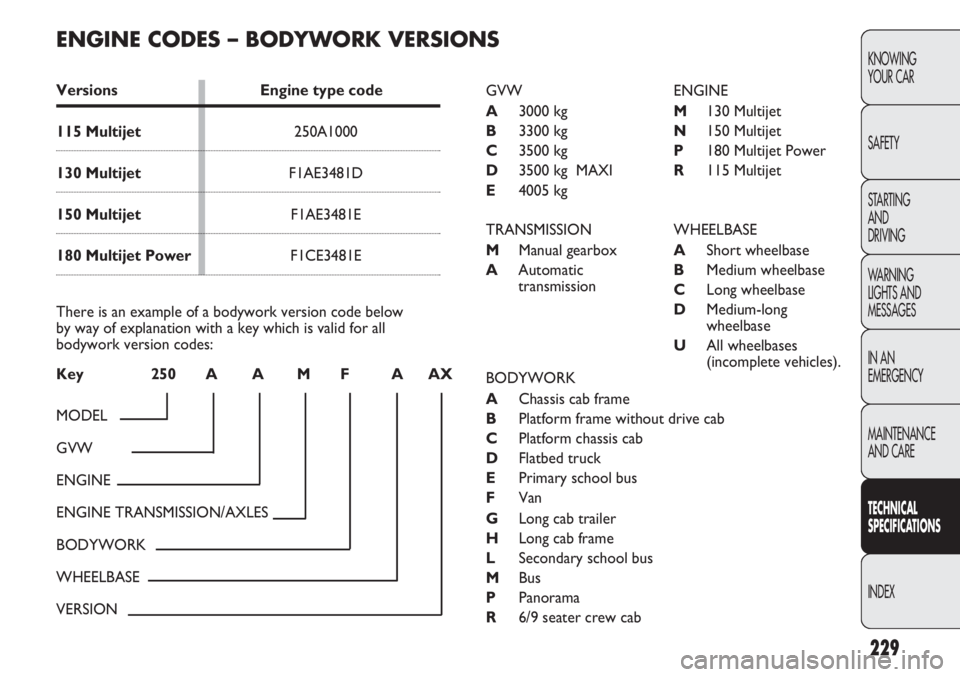
229
KNOWING
YOUR CAR
SAFETY
STARTING
AND
DRIVING
WARNING
LIGHTS AND
MESSAGES
IN AN
EMERGENCY
MAINTENANCE
AND CARE
TECHNICAL
SPECIFICATIONS
INDEX
ENGINE CODES – BODYWORK VERSIONS
Versions Engine type code
115 Multijet250A1000
130 MultijetF1AE3481D
150 MultijetF1AE3481E
180 Multijet PowerF1CE3481E
There is an example of a bodywork version code below
by way of explanation with a key which is valid for all
bodywork version codes:
Key 250 A A M F A AX
MODEL
GVW
ENGINE
ENGINE TRANSMISSION/AXLES
BODYWORK
WHEELBASE
VERSION
GVW
A3000 kg
B3300 kg
C3500 kg
D3500 kg MAXI
E4005 kg
TRANSMISSION
MManual gearbox
AAutomatic
transmissionENGINE
M130 Multijet
N150 Multijet
P180 Multijet Power
R115 Multijet
WHEELBASE
AShort wheelbase
BMedium wheelbase
CLong wheelbase
DMedium-long
wheelbase
UAll wheelbases
(incomplete vehicles).
BODYWORK
AChassis cab frame
BPlatform frame without drive cab
CPlatform chassis cab
DFlatbed truck
EPrimary school bus
FVan
GLong cab trailer
HLong cab frame
LSecondary school bus
MBus
PPanorama
R6/9 seater crew cab
Page 234 of 287
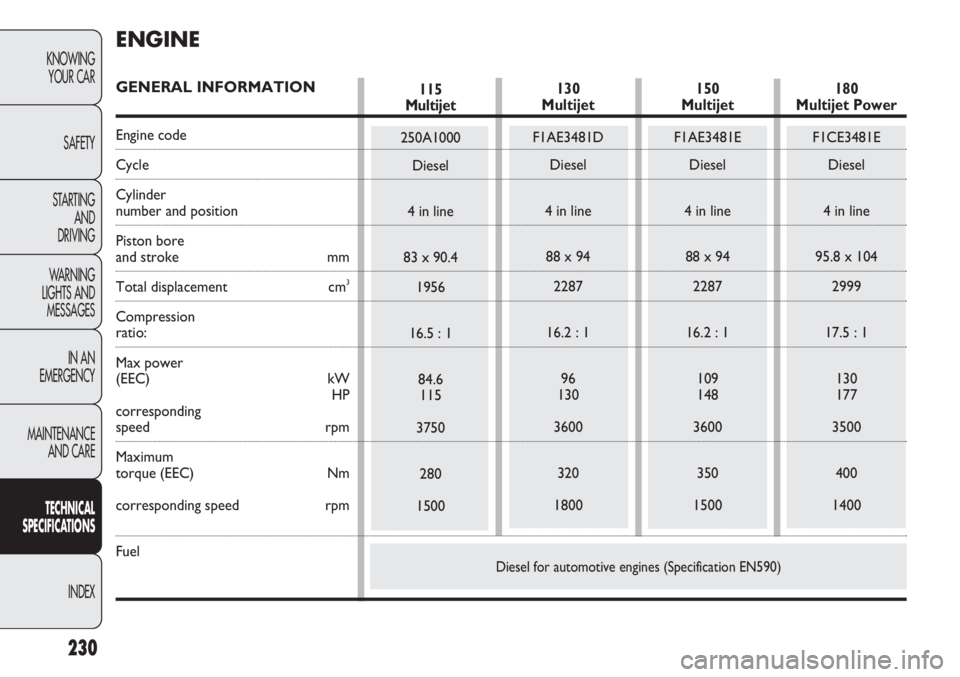
230
KNOWING
YOUR CAR
SAFETY
STARTING
AND
DRIVING
WARNING
LIGHTS AND
MESSAGES
IN AN
EMERGENCY
MAINTENANCE
AND CARE
TECHNICAL
SPECIFICATIONS
INDEX
Diesel for automotive engines (Specification EN590)
130
Multijet
F1AE3481D
Diesel
4 in line
88 x 94
2287
16.2 : 1
96
130
3600
320
1800
150
Multijet
F1AE3481E
Diesel
4 in line
88 x 94
2287
16.2 : 1
109
148
3600
350
1500
180
Multijet Power
F1CE3481E
Diesel
4 in line
95.8 x 104
2999
17.5 : 1
130
177
3500
400
1400
115
Multijet
250A1000
Diesel
4 in line
83 x 90.4
1956
16.5 : 1
84.6
115
3750
280
1500
ENGINE
GENERAL INFORMATION
Engine code
Cycle
Cylinder
number and position
Piston bore
and stroke mm
Total displacement cm3
Compressionratio:
Max power
(EEC) kW
HP
corresponding
speed rpm
Maximum
torque (EEC) Nm
corresponding speed rpm
Fuel
Page 235 of 287
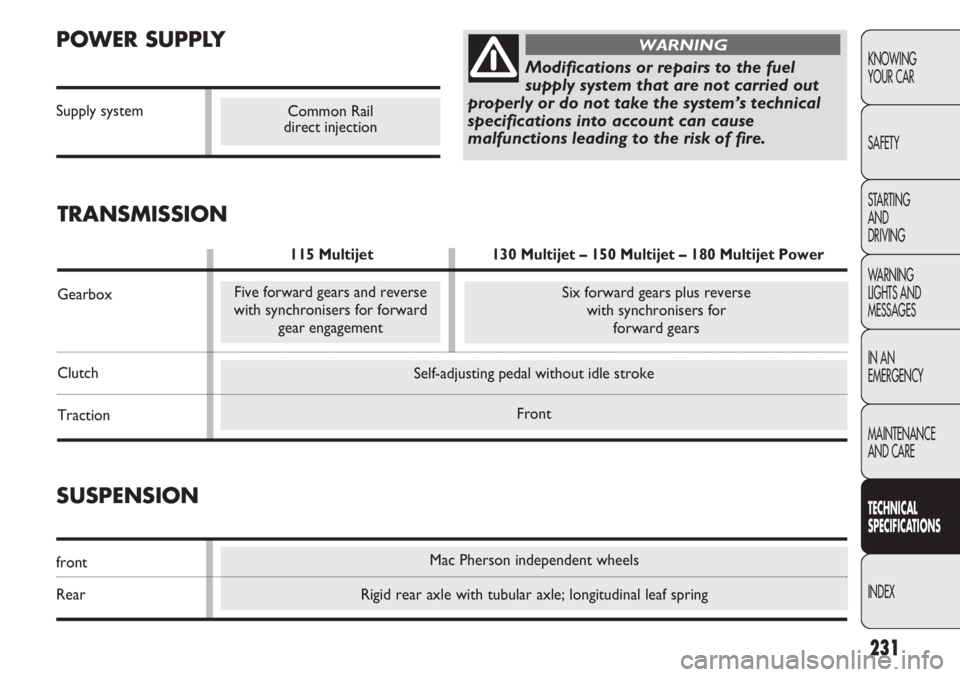
Mac Pherson independent wheels
Rigid rear axle with tubular axle; longitudinal leaf spring
Self-adjusting pedal without idle stroke
Front
Modifications or repairs to the fuel
supply system that are not carried out
properly or do not take the system’s technical
specifications into account can cause
malfunctions leading to the risk of fire.
POWER SUPPLY
Supply system
231
KNOWING
YOUR CAR
SAFETY
STARTING
AND
DRIVING
WARNING
LIGHTS AND
MESSAGES
IN AN
EMERGENCY
MAINTENANCE
AND CARE
TECHNICAL
SPECIFICATIONS
INDEX
WARNING
Common Rail
direct injection
SUSPENSION
front
Rear
Six forward gears plus reverse
with synchronisers for
forward gearsFive forward gears and reverse
with synchronisers for forward
gear engagement
TRANSMISSION
115 Multijet 130 Multijet – 150 Multijet – 180 Multijet Power
Gearbox
Clutch
Traction
Page 236 of 287
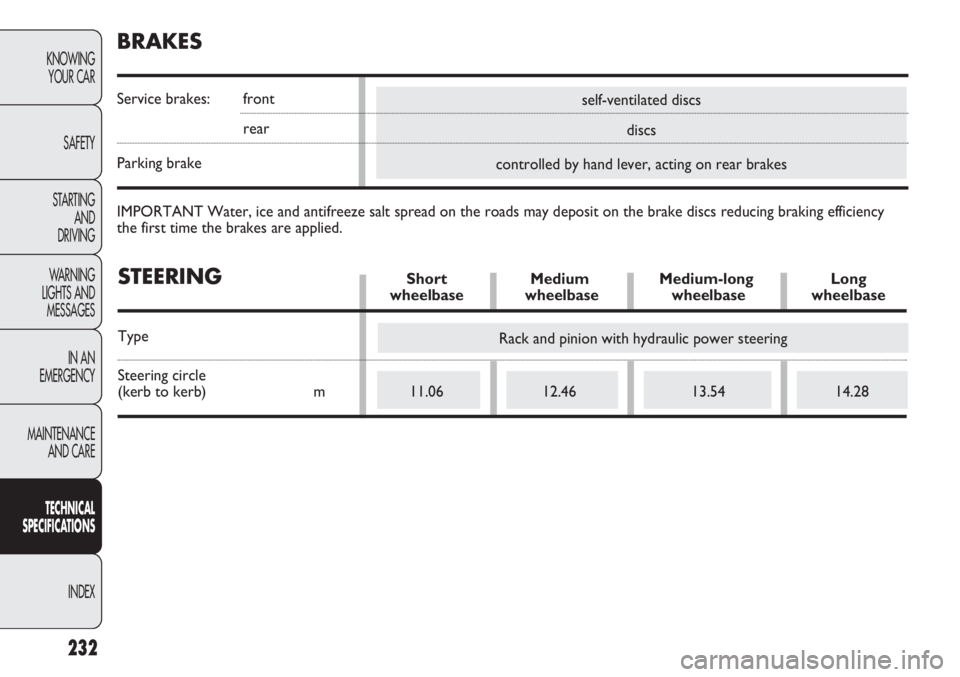
self-ventilated discs
discs
controlled by hand lever, acting on rear brakes
232
KNOWING
YOUR CAR
SAFETY
STARTING
AND
DRIVING
WARNING
LIGHTS AND
MESSAGES
IN AN
EMERGENCY
MAINTENANCE
AND CARE
TECHNICAL
SPECIFICATIONS
INDEX
STEERINGShort Medium Medium-long Longwheelbase wheelbase wheelbase wheelbase
Type
Steering circle
(kerb to kerb) m 11.06 12.46 13.54 14.28
Rack and pinion with hydraulic power steering
BRAKES
Service brakes: front
rear
Parking brake
IMPORTANT Water, ice and antifreeze salt spread on the roads may deposit on the brake discs reducing braking efficiency
the first time the brakes are applied.
Page 237 of 287
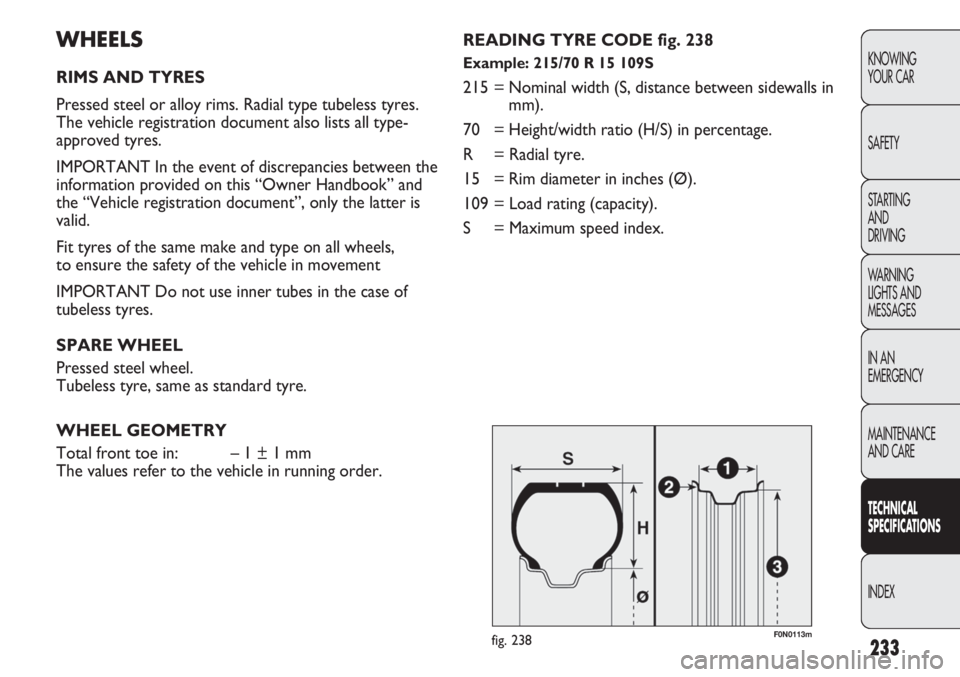
233
KNOWING
YOUR CAR
SAFETY
STARTING
AND
DRIVING
WARNING
LIGHTS AND
MESSAGES
IN AN
EMERGENCY
MAINTENANCE
AND CARE
TECHNICAL
SPECIFICATIONS
INDEX
WHEELS
RIMS AND TYRES
Pressed steel or alloy rims. Radial type tubeless tyres.
The vehicle registration document also lists all type-
approved tyres.
IMPORTANT In the event of discrepancies between the
information provided on this “Owner Handbook” and
the “Vehicle registration document”, only the latter is
valid.
Fit tyres of the same make and type on all wheels,
to ensure the safety of the vehicle in movement
IMPORTANT Do not use inner tubes in the case of
tubeless tyres.
SPARE WHEEL
Pressed steel wheel.
Tubeless tyre, same as standard tyre.
WHEEL GEOMETRY
Total front toe in: – 1 ± 1 mm
The values refer to the vehicle in running order.
F0N0113mfig. 238
READING TYRE CODE fig. 238
Example: 215/70 R 15 109S
215 = Nominal width (S, distance between sidewalls in
mm).
70 = Height/width ratio (H/S) in percentage.
R = Radial tyre.
15 = Rim diameter in inches (Ø).
109 = Load rating (capacity).
S = Maximum speed index.